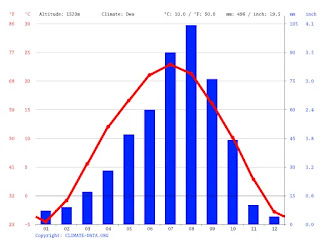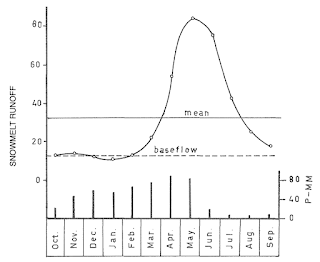Stunningly beautiful, it is also super unusual and interesting. Here is why:
Christ is depicted in a globe of light, pulling Adam by his wrist out of Hades...Literally...As Hades is depicted as a mountain with human face...
Here is a Hades's head detail enlarged. Hades is depicted as an old man with a long beard with his mouth opened and an expression of pure terror. He is facing away from Christ, but he seems to be trying to get a glimpse of what's happening behind his back...
Very good analysis. But there are few bits that he missed...
This depiction of Hades as an anthropomorphised mountain is very strange...Because Hebrew Sheol, Greek Hades and Christian Hell were all believed to be located "under the surface of the earth, below"...
Yet the dead were depicted on this fresco to be "inside of a mountain"...I know, I know...We could say that this is technically "under the surface of the earth, below", but...
Have you ever heard of Ekur? Ekur, "the mountain house of the dead" from Sumerian mythology?
Ekur is one of the names for the earth, but is applied more particularly to "that part of the mountain"...where the gods were born...And from where they came to Sumer...
These mountains are actual, real mountains, north east of Sumer, where the first civilisations arose, where grain agriculture was invented. I talked about this in my post about "How grain came to Sumer"...
And in the earliest Sumerian mythology, it was on this mountain that the gods were supposed to dwell.
Hence Ekur became also one of the names for "temple", as the seat of a god, temple which was shaped to look like a mountain...
And it is inside this holy mountain that we find the land of the dead...And guess who is the God of the Dead in the Sumerian mythology? The Sun...
The Sumerian poem "Enki and the World Order" exclaims: Young Utu (the sun), father of the Great City (the realm of the dead, underworld)...I talked about it in my post "Soul bird"...
And until today it never occurred to me why it was "Young Utu/Shamash" who was the "God of Ekur"...
The Holy Mountain, Ekur, The mountain of gods and mountain of the dead, is also the source of Tigris and Euphrates...
It is the snowmelt runoff from these mountains that is the main source of the Holy Rivers...
Snowmelt which is the result of the spring sun getting higher and higher in the sky, and heating higher and higher ranges of the mountains, melting more and more snow...Which creates bigger and bigger snowmelt runoff...Which causes water level in Tigris and Euphrates to rise...
And so, symbolically 🙂, it is Young Utu/Shamash, Spring Sun, who every spring climbs up the Holy Mountain to release Enki/Ea, (god of) fresh water, from (his) it's icy prison...
And poetically 🙂, in "Enki and Ninhursanga" we read that "When Utu [the sun god] steps up into Heaven (Holy mountain), fresh waters shall run out of the ground for you"...
Sun, brings water which in Sumer literally resurrects life...At the moment when sun (solar year) is about to enter "the land of the dead", hot dry season...
Oh, BTW, Leo (Jul/Aug) marks the beginning of the main mating season of Eurasian lions...Hence Leo...
Anyway, this is why it is "Young Utu", Spring Sun, who is the god of "the mountain house" of the dead...
Compare that to Christ, Son of God, going into the mountain of the dead as an orb of light, in Spring...
Interesting...
BTW, Slavs believed this: "...the souls of our ancestors shine every morning from Iriy (Slavic Paradise)..."
There are two worlds, the world of the living and the world of the dead. The sun spends the day in the world of the living and the night in the world of the dead...
And there are two gates that stand on the border between these two worlds: the eastern gate and the western gate...
Every morning the eastern gate is opened by Danica, the day star, which is in the morning called Zornjača, the morning star, and the sun comes from the world of the dead into the world of the living...
And every evening the sun goes from the world of the living into the world of the dead through the western gate, which is then closed behind him by Danica, the day star, which is in the evening called Večernjača, the evening star...
The souls of the dead follow sun to the western gate, which is where the entrance into the land of the dead is...
And there they enter Iriy, the ever green land of eternal spring, full of cattle...Raj..Paradise. And every morning, when the eastern gate of the world of the dead is opened, they smile on us...
Also: In Ireland there was a belief that the souls of the dead departed westwards over the sea with the setting sun...
And Serbs believed that their Supreme god Dabog, Giving God, was both Sun God, Rain (water) God and God of the Dead...
Where does the sun come from in the morning and where does it go back in the evening?
The same observation resulted in Dabog, Serbian Sun god, Serbian ancestral deity, having all the characteristics of the god of the dead, and having the cult which is in its essence a cult of the dead...According to Serbian ethnographers...
People are logical...
This is also the reason why the dead play such a huge role in Slavic agricultural cult...Not only that the life literally grows out of the dead...But Dabog, The Sun, the father of the living, and the dead, resides among the dead...
And if the dead are not happy with the living, and if they complain to "Their Father", Dabog, about the living...Then the living are basically fucked...I talked about this in my posts "Diduch", "Julenek", "White feast"
Hittites forgot about their dead, and look what happened to them:
"...humiliation of the Hittite kingdom is the result of the fact that the living Hittite kings and their subjects have forgotten to respect the sacred bond with their dead..." - From the letter of the last Hittite king, Suppiluliuma II...
So, Dejan Gorgievski thought this was a very interesting fresco...I think it's even more interesting than he was aware of...






























































